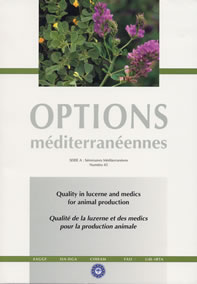| Article précédent | p. 41-46 | Article suivant |
Tetraploid alfalfa mapping using AFLP markers and research of markers of pollen fertility
Molecular markers and mapping methods were applied in tetraploid alfalfa. The mapping population included 180 F1 individuals (Provence variety Magali by the Flemish variety Mercedes). With seven primer pairs, 186 dominant AFLP markers were obtained. For mapping, the markers used were those segregating in F1, present in one parent and absent in the other, but also those present as simplex in both parents. Calculation was described. These biparental simplex markers make it possible to combine the maps of the two parents. For each parent, 8 linkage groups among the 32 expected were obtained. More markers are needed to complete the map. Pollen fertility from parents and F1 individuals was measured. Seven markers explained between 9 and 22 per cent of the phenotypic variation each. Feasibility of mapping and research of markers linked to agronomic traits was proved in alfalfa. Next months we shall try to find more AFLP markers and codominant markers to increase map saturation.
- [ Afficher ]
- [ Télécharger ]
- [ Exporter la citation ]
Vous pouvez télécharger la citation au format :
- [ Imprimer ]
-
Mots-clés
MARQUEUR GENETIQUE, MEDICAGO SATIVA, POLYPLOIDIECiter cet article
Julier B., Henri D., Ecalle C., Huyghe C. Tetraploid alfalfa mapping using AFLP markers and research of markers of pollen fertility. In : Delgado I. (ed.), Lloveras J. (ed.). Quality in lucerne and medics for animal production . Zaragoza : CIHEAM, 2001. p. 41-46. (Options Méditerranéennes : Série A. Séminaires Méditerranéens; n. 45). 14. Réunion Eucarpia du Groupe Medicago spp., 2001/09/12-15, Zaragoza and Lleida (Spain). http://om.ciheam.org/om/pdf/a45/01600054.pdf



